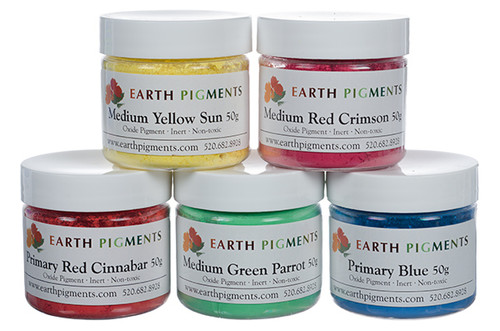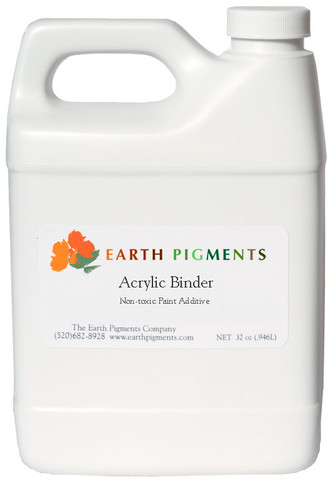Product Details
Instructions for use
Ditch the acrylic! Nature’s Resin is a non toxic, plant based multi purpose/multi surface binder. It can be used as a paint binder, an additional binder in water based applications, a glue and even as a sealer. It dries to a permanent, water resistant film that is non yellowing and flexible. Free from harmful chemicals, it is ideal for those with chemical sensitivities. Mixing is easy! Any of our Ochers, Pigments or Mica Powders will be compatible.
To create paints
Nature’s Resin will have the fluidity much like an acrylic paint. For small quantities of art paint to use or store, pour Nature's Resin onto your palette or glass. Add pigment to the resin in small increments, mixing with your palette knife until a smooth mix is achieved. Mix a lesser amount of pigment for a more translucent paint, and more pigment for a thicker more opaque paint. Just as with a watercolor, a draw down test can be performed if desired to be sure all the pigment particles have been properly mixed.
As a creative variegated finish for walls
Nature’s Resin can be used over flat latex wall paints and primers as a wall glaze to create a stunning effect. The mixing procedure is slightly different from making paint. Instead, a color paste with the pigment is created first. In your mixing vessel, put the measured pigment powder down first. The ratio will be 1 part pigment to 3 parts resin by volume. Add water to the pigment only in small increments, mixing well until a smooth color paste has been achieved. The measured amount of Nature's Resin is then added to the pigment and worked well until a smooth, creamy glaze has been achieved. It is best to mix small batches at a time as you work. Apply to flat finishes such as over flat latex paints or primers using a paint brush or damp sponge. Any faux finish tool can be used to create varying effects, such as a crumpled plastic grocery bag or a foam roller with chunks cut out to create texture. For the most pleasing effect, the application should then be further manipulated. Soften the look by further working with a slightly damp rag, paying close attention to the edges to avoid obvious demarcation lines.
The effect will not be monotone, but instead will be a contrasted,variegated finish of light and dark areas. This will recreate a classic Old World look of plasters and lime washes. It is best to tackle the wall by doing random areas all over, feathering the edges as you apply. Then connect them as you complete the application. Areas where new pigmented resin is applied over a previous coat will appear darker. This can be the challenging part of application as it can create obvious demarcation lines. However by feathering and randomly applying, these light and dark areas become part of the final look, recreating the variegated finish of an antique wall. If you wish to soften the effect of the pigment, Whiting Chalk can be used with the pigment to create a lighter tone, or further manipulation with a damp rag while the finish is still wet can also work to soften the effect. Rags or sponges should be slightly damp, not wet or dripping!
Making test samples for wall finishes
It is always recommended to test your color and application technique for this type of finish by creating small samples first. Practice may be necessary to perfect the technique. You can create test boards by painting cardboard with the same paint used on the wall. It is important that your test surface have the same absorbency as this will affect your application technique. Create your test paint batches using 1 teaspoon pigment to 1 tablespoon resin (1 to 3 ratio) Prewet the pigment as instructed, then add the resin and mix well to make a smooth, creamy paint. Be creative and try different application tools to see what creates the best effect.
After creating samples, try the effect on an inconspicuous part of the wall. Doing a small 3 ft by 3 ft area, test your technique. If it is undesirable, you have a window of time that you can scrub it off the wall with a scrubbing sponge, using soap and water.
Coverage depends upon the absorbency of the wall and how many layers are applied. A typical application will be 25 to 50 sq ft per 8 oz of resin with pigment.
Nature’s Resin can be painted over in the future with latex wall paints.
Coverage depends upon the absorbency of the wall and how many layers are applied. A typical application will be 25 to 50 sq ft per 8 oz of resin with pigment.
As an additional binder in water based paints
When making natural paints, often it is desirable to add our Acrylic Binder as an additional binder to increase strength. Ditch the acrylic and use Nature’s Resin instead (interior applications only).
Milk and Casein Paints, lime washes, methyl cellulose distemper paints, etc can all be fortified by adding up to 20% (usually 5 to 10%) of your total paint formulation in resin by volume. Measure and mix into the formulation until fully dissolved. It may be helpful to dilute the resin first by adding some water from your recipe before adding into the final batch.
As a glue
Can be used full strength as a craft glue, or thin with water as necessary.
As a sealer
Nature’s Resin will dry to a clear, flexible film so it makes a great sealer for projects. Brush on full strength for a mar resistant finish.
As a strengthener in plasters and cements
Dilute your resin by up to 1 part resin to 5 parts of the volume of water in your plaster or cement mix to increase strength as you would with an acrylic admixture, (not for exterior applications).
Clean up
Nature’s Resin is safe for drains. However best practice would be to wipe up as much residue as possible and throw it into the trash, then clean surfaces and tools with warm, soapy water. When through dispensing, clean the neck of the bottle with a damp cloth to prevent excess product from sticking to the cap.
NOTE:
Nature’s Resin is not for aquariums, or use where it will be subjected regularly to water. It is not an exterior component. For exterior applications, use our Acrylic Binder. Nature’s Resin is not considered biodegradable but is safe for the environment. It is expected to have the same archival life as an acrylic if kept in proper conditions for art materials.




